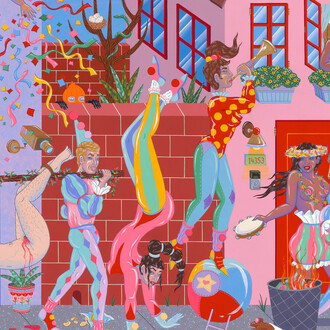Kayne Griffin Corcoran is pleased to present a solo exhibition of new work by Raul Guerrero. This will be the first exhibition of the artist with the gallery and will include recent paintings that investigate place, history and the artist’s biographical relationship to the Sonoran Desert region.
“Driving through the hot desert in the 1950’s from Blythe to Phoenix via Highway 60 always yielded interesting sites and experiences. Inevitably our car would heat up requiring a stop at a Quartzsite gas station to pour water down the radiator. These gas stations always featured some sort of tourist attraction which for a quarter allowed you to view desert fauna, maybe a giant Gila Monster or a garden with cacti, crystals geodes and postcards for sale. The postcards cost 5 cents and allowed communication with the world beyond. To the point: in the heat of 110 degrees these stops appeared as mirages to me, you know, those that inspire the imagination.”
Sonoran Desert: Flora, Fauna, Artifacts acts as an ethnographic study into the region that encompasses Northwest Mexico and Southwestern United States. It’s the land from which Guerrero’s family came and where he lived as a youth. Subsequently it is also the landscape that has inspired his artistic thinking, often directly related to the indigenous people of the area.
Guerrero’s paintings piece together like snapshots that lend themselves to a larger narrative. One painting titled Canyon de Chelly, comes from a photograph the artist took in 1989. While standing opposite of the famous cliff dwellings, he looked down and spotted a pile of multi-colored stones that beckoned him to be rearranged into a portrait. Years later he reflects on the photograph and understands that the act of arranging the stones was an attempt to channel the former inhabitants of the dwellings. The stone portrait appears in several other paintings by Guerrero, serving as a metaphor for the way in which his ancestors appear in his own creative process.
Also included in the show are a new series of paintings on rotating discs. These works appropriate iconography from the Hohokam and Mimbres culture, two indigenous societies that occupied the Northern Region of the Southwest (now parts of Arizona and Sonora, Mexico.) These motorized paintings spin at a slow pace of 9 rpm. Akin to Duchamp’s Rotoreliefs which were made to create an optical illusion that would change one’s perception of depth, Guerrero’s paintings turn history onto its head.
Raul Guerrero has been exploring identity and culture through his practice for over four decades. Having attended Chouinard Art Institute in the late 1960s, Guerrero became influenced by a generation of Los Angeles artists, like John Baldessari or Ed Ruscha, that had investigated the regional environment. Working alongside friends such as Allan Ruppersberg, Jack Goldstein and William Leavitt, Guerrero’s practice articulated his position as a Mexican-American artist in Southern California.
Guerrero’s early work was sculptural: creating tableaus that included film, video, photography, and found and appropriated objects. It wasn’t until 1984 when he made a distinct decision to forego sculptural projects and instead attempt to render the world’s he was excavating into painting. The finished product was the Oaxaca Series that Allen Ruppersberg described as having a “style [that] might be defined as primitive but not naïve, with a touch of magic realism from the time and incorporating a narrative feeling of space coming from his sculptural tableaus of the past.”
Raul Guerrero lives and works in San Diego, CA. He has been exhibiting his work since 1974 with solo shows at Los Angeles galleries including Claire Copley Gallery, Cirrus Gallery, Thomas Lewallen and Richard Kuhlenschmidt. Guerrero has had solo exhibitions at the San Francisco Art Institute (1976), the Long Beach Museum of Art (1977) and the Athenaeum Music and Arts Library (2007 & 2013). His 1989 retrospective exhibition was presented at the Museum of Contemporary Art, San Diego. Guerrero’s Oaxaca paintings were the subject of an exhibition at the CUE Art Foundation, New York in 2010, curated by Allen Ruppersburg. Guerrero was the recipient of an NEA Photography Fellowship (1979) and the San Diego Art Prize (2006). His work has recently been included in exhibitions at Air de Paris Gallery, Paris (2015); Ortuzar Projects, New York (2018); Chateau Shatto, Los Angeles (2018); Honor Fraser, Los Angeles (2016); Potts, Alhambra (2018).
















